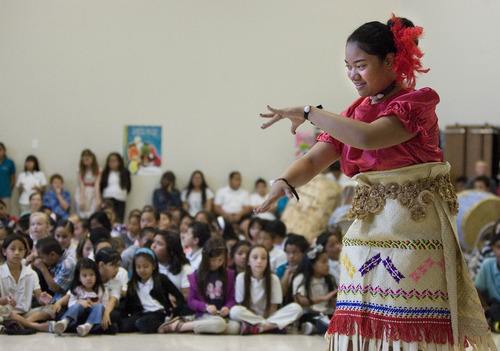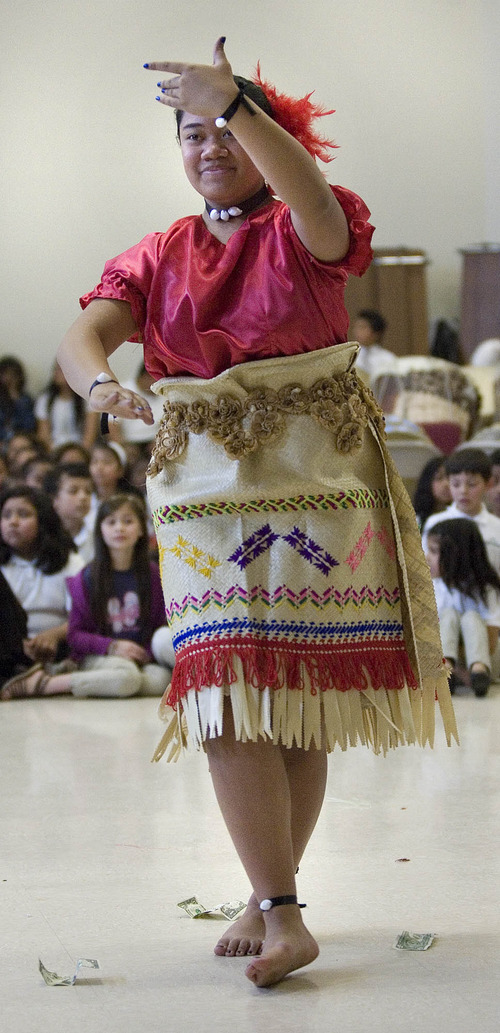This is an archived article that was published on sltrib.com in 2013, and information in the article may be outdated. It is provided only for personal research purposes and may not be reprinted.
A touch of Tonga came to Salt Lake City on Friday at Pacific Heritage Academy.
Outside the school, a somewhat traditional roasting pit, or umu, had been dug, and men slowly turned a whole pig over the sizzling embers.
Inside, many of the 450 students were dressed in formal attire, which for the boys included a tupenu (skirt) and a ta'ovala (mat) worn around their waist and kept in place by a belt. Girls wore long dresses and ta'ovala as well, some adorned with shell decorations.
Six-year-old Luisa Haungatau wore a traditional dress, made by her mother and grandmother, called a teunga kakala, which is worn when performing for royalty. Her mother, Sophia Haungatau, smeared baby oil over her daughter's arms and legs, a traditional measure to make the dancer shine.
Haungatau, who graduated from East High School, said her daughter has an advantage being enrolled in the new charter school, which opened this school year.
"I think her education will be better; a lot of people send [their children] to the island, but she can be American and learn about her heritage [at this school]," the mother said.
It's about an 18-hour flight from the United States to Tonga, an archipelago of 150 islands, 36 of which are inhabited, in the South Pacific.
Over the coming months, Principal Ofa Moeai said, the school will be highlighting its Heritage Language Program. Students can take classes in Tongan, Samoan and Spanish languages.
The school also hosts a Navajo language preschool project.
Half of the school's students are Tongan, its largest ethnic group.
"[Our language] program is different from a 'foreign language' program because our teachers instruct students with the assumption that students have a social and emotional tie with the language," Moeai said.
The charter school is the first in the nation based on the concept that teachers will incorporate Pacific Islander culture into lessons while emphasizing a hands-on approach to learning.
Also called "expeditionary" learning, it revolves around five main ideas: Learning is active, public, meaningful, challenging and collaborative.
For example, that means students learn about different cultures by studying cloth: Mormon pioneer quilts, Navajo rugs and traditional Tongan tapa cloth.
Recently, students traveled to Hawaii for a travel-study program and visited the Brigham Young University campus.
"They learned about the coral reefs and global warming and its effect on the island nations," Moeai said.
In 2010, Utah had more than 36,000 people of native Hawaiian or Pacific Islander mixed-race descent. Mormon missionaries have been instrumental in encouraging Tongan immigration to the U.S.
Marry Fisi, 13, summed up Tongan Heritage Day as she prepared to dance before 100 or so family and friends. "Dancing makes me proud of myself," she said.
The school will celebrate Latin Heritage Day on April 26, Native American on May 10 and Samoan on May 17.
Twitter@rayutah —
Celebrating cultures
Pacific Heritage Academy is hosting "We are Many, We are One," a celebration of community cultural heritages. It celebrated Tongan Heritage Day on Friday. Upcoming events:
Latin Heritage Day Celebration
Friday, April 26
9 a.m. to 1 p.m.
Cooking demonstrations, handicraft and art exhibits
11 a.m. Performances: song, dance and speeches
7 p.m. to 10 p.m. Family dance
Olta' Yazi Powwow
May 10
1 p.m. Little Feathers performance
5 p.m. to 10 p.m. Powwow
Samoan Heritage Day Celebration
May 17
9 a.m. to 1 p.m.
Cooking demonstrations, handicraft and art exhibits
11 a.m. Performances: song, dance and speeches
7 p.m. to 10 p.m. Family dance







